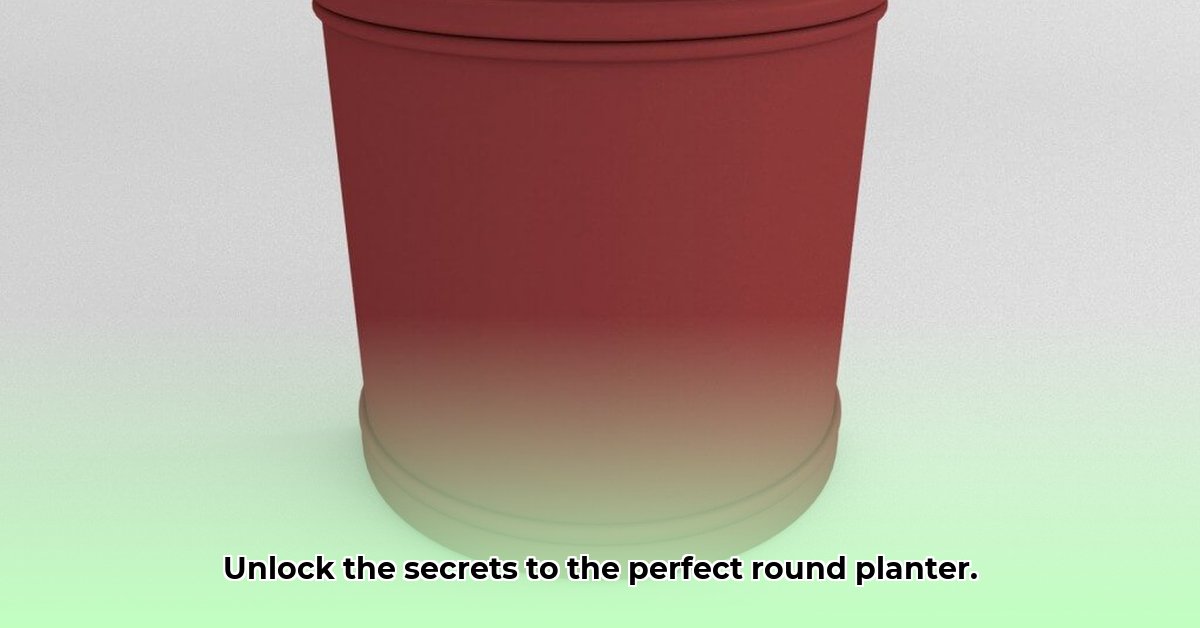Round planters are versatile additions to any space, from small apartments to sprawling patios. They add a touch of style and provide a beautiful way to showcase your favorite plants. However, with so many options available, choosing the right one requires careful consideration. This comprehensive guide provides you with all the information you need to find the ideal round planter for your home and garden. From assessing your specific needs to understanding the different materials and styles, we’ll cover everything you need to make an informed decision and cultivate a thriving green space.
Round Planter Selection: Your Complete Guide to the Perfect Pot
Selecting a round planter may seem simple on the surface, but the sheer variety of options can quickly become overwhelming. This guide offers a structured approach to ensure you choose the perfect pot, not just for your plants, but also one that complements your aesthetic preferences and lifestyle. Let’s explore the key factors involved in this process to help you make the best choice and create a stunning display.
Understanding Your Needs: The Plant Parent’s Pre-Shopping Checklist
Before you even begin browsing, take some time to identify your specific requirements. Answering these questions will significantly narrow down your choices and prevent buyer’s remorse:
- What plants are you planning to grow? A tiny succulent requires a drastically different environment than a robust tomato plant. Knowing the mature size, water requirements, and sunlight needs of your plant is absolutely crucial for adequate root development and overall health. Consider the specific needs of species.
- Where will the planter live? Indoor planters are shielded from the elements, while outdoor planters must withstand harsh weather conditions. Exposure to direct sunlight, rain, wind, and temperature fluctuations will influence the planter’s material, durability, and longevity. Choose a planter suited for the intended environment.
- How much space do you have? Carefully measure the available area, both horizontally and vertically, to ensure the planter fits comfortably without obstructing pathways or overwhelming the space. Consider traffic flow, especially in outdoor settings, to avoid accidental bumps and spills.
- What’s your budget? Planters range from affordable mass-produced options to high-end, handcrafted pieces. Establishing a realistic budget beforehand will help you narrow your search and avoid the temptation of overspending. Remember to factor in the cost of soil, fertilizer, and other necessary supplies.
- What style are you going for? The planter should complement your existing decor and personal taste. Modern, rustic, bohemian, minimalist – each style requires a different planter aesthetic in terms of color, texture, shape, and overall design. Consider the existing elements.
Material Matters: Picking the Right Stuff for the Job
The material of your planter plays a significant role in its durability, water retention, insulation and overall appearance. Each material has unique advantages and disadvantages, so carefully consider these popular options:
| Material | Pros | Cons |
|---|---|---|
| Ceramic | Elegant, durable, excellent water retention (reducing watering frequency), available in vast array of colors and intricate designs | Heavy, can break if dropped or exposed to freezing temperatures, often more expensive than other options, may require more careful watering to prevent over-saturation |
| Plastic | Lightweight, extremely affordable, highly durable (resistant to cracking and fading), comes in a wide variety of colors and styles, easy to clean | Can fade or become brittle in direct sunlight over time, might not have the same aesthetic appeal as natural materials, may contribute to plastic waste |
| Wood | Natural beauty, rustic charm, biodegradable and sustainable option (if sourced responsibly), provides good insulation for roots | Requires regular maintenance (sealing and protection from rot, insects, and moisture), can be relatively pricey depending on the type of wood, susceptible to water damage |
| Metal | Modern, highly durable, can be painted or powder-coated for various looks, resistant to pests and diseases | Can rust (unless treated with a rust-resistant coating), can heat up quickly in direct sunlight, potentially scorching plant roots, may be heavier than plastic |
| Fiber Cement | Exceptionally durable, weather-resistant (withstands extreme temperatures and conditions), low maintenance, can be molded into various shapes and textures | Heavy, can crack if mishandled during transport or installation, may not be as visually appealing as other materials, limited color options |
| Resin Composite | Lightweight, durable, weather-resistant, less expensive than ceramic or fiberglass, available in a variety of finishes and textures | Might not have the same high-end aesthetic appeal as ceramic or natural wood, can sometimes appear artificial, may be susceptible to fading over time |
| Terracotta | Porous material allows for excellent aeration and drainage, classic and timeless aesthetic, relatively inexpensive | Dries out quickly, requiring more frequent watering, fragile and prone to cracking in freezing temperatures, can develop mineral deposits on the surface |
For example, ceramic planters are an excellent choice for indoor orchids due to their moisture retention and elegant appearance. Conversely, plastic or resin planters are a practical and durable solution for outdoor use, withstanding various weather conditions without significant damage. Choosing the right material isn’t just about aesthetics; it’s about ensuring optimal plant health and maximizing the planter’s lifespan.
Sizing Up Your Style: From Tiny Tabletops to Grand Urns
Round planters are available in a diverse range of sizes and styles to suit every taste and application. Consider these factors when making your selection:
- Size: Determine the appropriate size based on the plant’s current size and anticipated mature dimensions. Root-bound plants will struggle to thrive, while excessively large pots can lead to overwatering and root rot. A general rule of thumb is to choose a planter that is slightly larger than the plant’s current root ball.
- Style: Select a design that harmonizes with your personal taste and complements the surrounding environment. Hanging baskets are ideal for saving space on balconies or patios, while sleek, modern planters offer a contemporary minimalist look. Explore online resources, garden centers, and home decor magazines for ample inspiration and ideas. Consider the overall theme and color palette of your space.
Essential Features: Going Beyond the Basics
Certain features can significantly enhance the functionality and ease of maintenance of your round planter. Don’t overlook these important considerations:
- Drainage Holes: Adequate drainage is absolutely essential for preventing soggy soil and root rot, a common killer of container plants. Ensure the planter has sufficient drainage holes to allow excess water to escape freely. If necessary, you can add additional drainage holes using a drill.
- Self-Watering Systems: Self-watering planters provide a consistent moisture supply to the plant’s roots, making them ideal for individuals with busy schedules or those prone to forgetting to water. These systems typically consist of a water reservoir and a wicking system that draws moisture up into the soil as needed.
- Saucers: Saucers are placed underneath the planter to catch any excess water that drains out, preventing spills and protecting surfaces. They also add stability to the planter, particularly on uneven surfaces. Choose a saucer that is slightly larger than the base of the planter.
- Portability: Consider planters with wheels or casters, especially for larger sizes, to make moving them for sunlight or cleaning easier.
Choosing the Right Planter for Your Plant: The Perfect Match
Selecting the appropriate planter size for your plant is crucial for promoting healthy root development and preventing overcrowding. As a general guideline, choose a planter that is at least 2-4 inches larger in diameter than the plant’s current pot. Potting up your plant every one to two years, as it grows, will ensure continuous healthy growth and prevent it from becoming root-bound.
Shopping for Your Perfect Planter: Where to Find It
You can find your ideal round planter at a variety of retailers, both online and in brick-and-mortar stores:
- Online Retailers: Amazon, Wayfair, Etsy, and specialized online garden stores offer a vast selection of planters in various sizes, materials, and styles.
- Home Improvement Stores: Home Depot, Lowe’s, and other home improvement stores typically carry a wide range of planters, particularly during the spring and summer months.
- Local Garden Centers: Local garden centers often offer unique, locally made planters, as well as expert advice on selecting the right planter for your specific needs.
- Specialty Home Decor Stores: High-end home decor stores may carry designer planters and unique pieces that can add a touch of elegance to your space.
Before making a purchase, compare prices, read customer reviews, and carefully examine the product specifications to ensure you are getting a quality planter that meets your needs and preferences.
Keeping Your Planter Looking Its Best: Basic Care and Maintenance
Regular cleaning is essential for maintaining your planter’s appearance and preventing the buildup of dirt, debris, and algae. Wipe down the exterior of the planter with a damp cloth and mild soap on a regular basis. In addition to general cleaning, follow these material-specific tips for optimal care:
- Ceramic: Use gentle cleaning methods to avoid scratching the surface. Avoid abrasive cleaners or harsh chemicals.
- Plastic: Avoid harsh chemicals that can damage the finish or cause discoloration. Use a soft brush or sponge to remove dirt and grime.
- Wood: Regularly seal the wood with a protective sealant to protect against moisture damage, pests, and rot.
- Metal: Check for rust regularly and treat it as needed with a rust-inhibiting primer and paint.
By following these care instructions, you can ensure that your round planters remain in excellent condition for
- Modern Kitchen Backsplash Ideas To Inspire Your Refresh - December 19, 2025
- Modern Backsplash Ideas: A Guide to Todays Kitchen Trends - December 18, 2025
- Ceramic Kitchen Wall Tiles: Style and Protection for Your Walls - December 17, 2025









